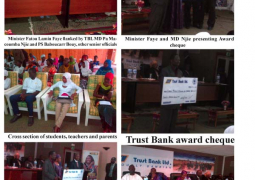Born in December 1942 in the Upper River Region, he joined the Civil Service in the dying days of colonial rule, in 1962. His tall and slender height must have attracted Captain Peters, the legendary Director of Information in the 1960s, when he was scouting for a cameraman for the department. In 1970, Mr Sagnia was sent to train in the film production unit of the BBC, and also at th3e London Film School. He returned in 1972 an he became assistant cameraman/film producer for theFilm Production Unitcreated in 1969 under the Department of Information and Broadcasting then under the able directorship of the late historian and civil servant, Dr Lamin Mbye (1934-2004), and his blue eyed assistant,Suwaibou Conateh.
This Unit revolutionised Government media, which hitherto rested only on Radio Gambia, and the Gambia News Bulletin; the Film Unit brought Government activities and projects in words, sound and above all, moving images. Its short films on hygiene, environmental protection and State occasions shot variably on Reel or Betacam , were shown round the villages of the country to bewildered and highly impressed audiences. Between 1972 and 1980, the Unit under Mr Sagnia produced 8 films on various developmental issues, which were shown round the country by mobile film vans. Among the films were ‘The Gambia Counts her people’ (1972) to educate people on the 1973 census; ‘Ten years of nationhood’ (1975) on The Gambia’s ten years of independence; and ‘Fired Bricks’ (1`980) on how Gambians can use local materials to build their houses. Mr Sagnia was involved in all these productions as producer, director or editor.
In 1974, Mr Sagnia filmed the first and only visit ofPresident Jawara to Communist USSR; he was also at hand to film Jawara’svisits to Chairman Mao, the dying Chinese leader in 1975 and 1976. Footages of these historic diplomatic forays were shown round the country, and at the film room of the unit.
In 1980, he was promoted to Chief Film Producer and soon ably mentored and trained many future film crews and producers in the Film Unit. He was ambidextrous; Mr Sagnia able to shoot, edit, produce, script, record sound, laboratory, and even voice over films. His footage of the 1981 insurrection, taken at great personal risk, was widely used by foreign broadcasters.
In 1992, he was appointed Director of information. His tenure coincided with the controversial decision to transfer the then ailing Radio Gambia to GAMTEL, which he nonetheless oversaw creditably. When national TV service was introduced late 1995, Mr Sagnia was at hand to offer his two decades’ experience to the fledgling project. Even after retirement in 1998, he continued to offer his services to his people: he helped set up the multi-media unit at the Gambia Family Planning, and most recently, managed a local FM station and was some weeks ago, appointed chair of the newly formed Film Oversight Committee.
Immensely modest, soft spoken and meticulous Mr Sagnia was a fine gentleman, an adept film maker at par withthe greats like Moussa Kemoko Diakite of Guinea. A few weeks ago, he told me that he needed my help in his desire to write a short history of film making in The Gambia. He had just started the preliminary archival research, when he died. He also told me that he has digitised many hours of rare footage of moments of Gambian history, which document should be jealously protected by his family. I mourn the passing away of a good son of this land, and to his family and friend I pay my deepest condolences.
(Ebrima E. Sagnia, Pioneer Cinematographer, media administrator born 29 December 1942, died 12 April 2012)




